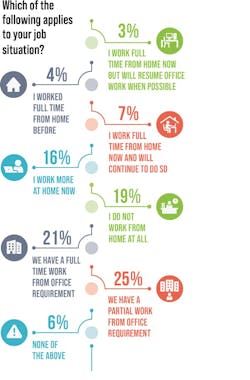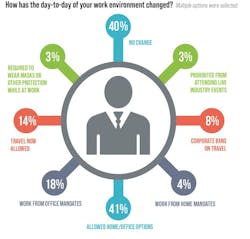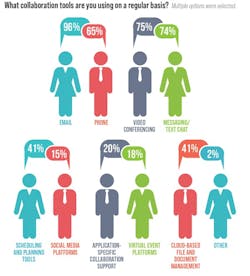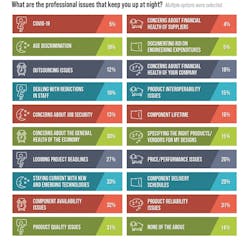This article is part of the Professional Advancement series: Annual Salary Survey.
What you’ll learn:
- How the Electronic Design/Microwaves & RF Salary Survey takes a snapshot of our industry.
- What we found out about remote work and online collaboration from our readership.
Electronic engineering has never been an easy vocation, and the pressures on the designer and developer to create products using the latest generation of technology and functionality continue to rise. Every year, Electronic Design and Microwaves & RF conduct a Salary Survey among our readership to get industry views and perspectives from the EE community about the way they work and their thoughts on the marketplace from their perspective.
Close to 1,000 readers responded to our 2023 Salary Survey, giving us a snapshot of the industry from the point of view of the working engineer. This is one of a series of analysis articles created by the editorial team, using the answers to get a better understanding of the workplace environment and how engineers design, develop, and collaborate.
Working Everywhere is the New Reality
One of the biggest impacts of the pandemic was how it changed the way people work. Where once an engineer was expected to show up at the office every day, now a lot of people work from home (Fig. 1).
Over 90% of survey respondents said they work from both a company office and their home, with a small but significant percentage of respondents (over 7%) indicating they work from home full time now. This is still exceeded by the number who work entirely in the office, which currently stands at about 20% of the community, while about 25% of respondents stated they have a partial work-from-office requirement.
The impact on where people work isn’t just limited to the day-to-day aspects of the job, it also affects travel and other presence-based activities. When asked how the day-to-day of their work environment changed (Fig. 2) when it comes to travel, about 60% of the respondents said they’ve experienced a change in their work situation. About 40% of the readership are allowed to work from both the home and office, approximately 8.5% have a corporate ban on travel, and a little over 3% stated they’re prohibited from attending live industry events.
The big takeaway from this set of questions is that the engineering community is reflecting the issues from the pandemic as a microcosm of how society at large is addressing it. In some ways, the migration to a more flexible workplace environment can be a benefit to a working professional, but it depends on how the company involved establishes the rules and relationships under which their employees work.
Collaboration Tools
The tools used by engineers to create, design, and develop have also been growing in utility and functionality, directly enabling people to work from anywhere. Collaborative software design tools and other ways to coordinate efforts remotely existed prior to the pandemic. However, in one way, COVID-19 created the “perfect storm” that pushed more companies and individuals to adopt them. This can even be seen in the expanded reliance on texts and emails to collaborate in a design effort.
When we asked our readers about the collaboration tools that they’re using on a regular basis, email was king at over 95%, exceeding even the telephone (65%) as a communications tool. Messaging and text chat applications made up about 75% of the responses, which was also the rough percentage of people using video conferencing software to collaborate (Fig. 3). Virtual event platforms are also growing in prominence, with close to 20%
Of course, all of this remote work means that scheduling and planning tools (41%) are important to coordinate efforts and schedule events. To manage, track, and store the work done, about 40% of the respondents said they use cloud-based file and document management solutions, and close to 20% work with application-specific collaboration support tools. Even social media is making an impact in the engineering community, with over 15% of the readership saying they use it in their work.
In this expanded employment of online tools, the engineering community is again mirroring the greater societal migration to a more online lifestyle—and not just in the working environment. The fact that social media is encroaching into the workplace underscores the expansion of the internet into more and more facets of our lives and working situation. The use and reliance on web- and cloud-based tools and business solutions will only grow as time moves forward.
Collaboration and the Work Environment
When it comes to the new collaborative environment, the people you work with remotely could be members of an internal team, or they could be employees of companies you're partnering with. The need for cross-company collaboration is underscored by the new electronic design ecosystem, which is forcing many companies to work at the edges or beyond their usual areas of expertise.
As a result, more companies are forming development partnerships, where they leverage one another’s skillset in the creation of a new design. Collaborative efforts not only address a company’s strengths and weaknesses, they also help the individual engineer. Roughly half of the engineers replying to the survey said they were being given more tasks outside of their main expertise, and collaborative efforts bring in more people with a more diverse palette of skills.
When asked if they’re doing projects that involves collaboration with other companies, respondents replied with a resounding yes (over 65%), which means a majority of companies in the electronic engineering business are working with at least one other company. This kind of cross-company collaboration demands that the tools used are highly functional, reliable, and resilient. Over 25% of the respondents said they’re collaborating more with others than they did in the past.
Workplace Issues
When it comes to the work itself, we asked our readership what keeps them up at night. The number one issue is staying current with new and emerging technologies (33.33%). This was followed by uneasiness about the general health of the economy, at 30.41% (Fig. 4).
Other major concerns dealt with industry issues, such as component availability (31.54%) and component delivery schedules (19.84%). Of course, they also worried about their own company as well, with product reliability (31.06%) and product quality (30.73%) foremost in their minds. When it came to issues resonating in the public space, e.g., age discrimination and outsourcing issues, there wasn’t much stress among the respondents, probably reflecting the professional career aspect of being an electronic design engineer.
Read more articles in the Professional Advancement series: Annual Salary Survey.





